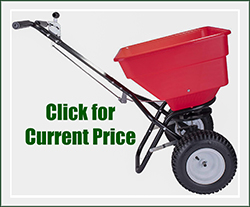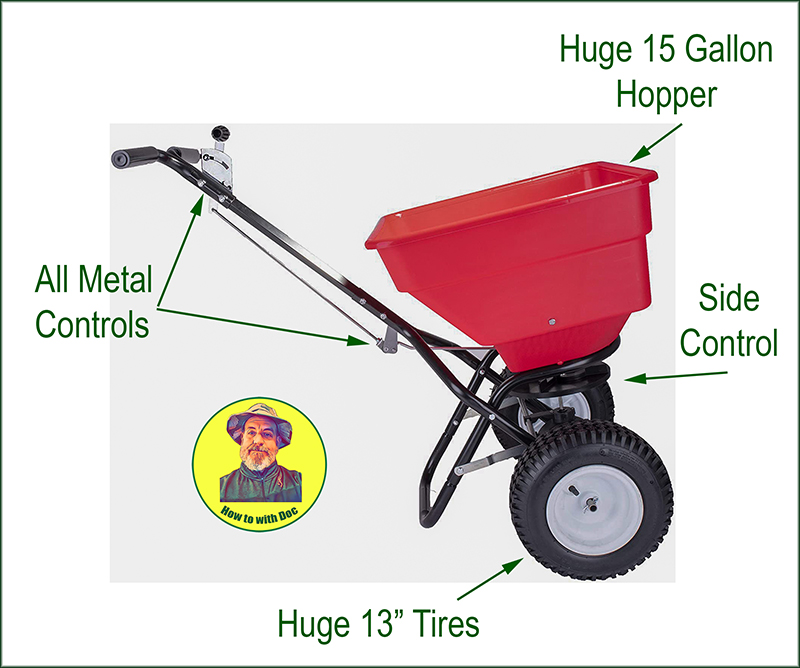Best Large Lawn Spreader
Once you USE IT… you’ll fall in love with its performance.
With more and more lawn treatments become lighter, the SIZE of your hopper becomes more important. The new ProGrade spreader is the perfect balance of hopper volume capacity, (15 gallons) carry weight (100 pounds), quality and price.
Lawn Spreader Tires… They make a huge difference.
When we were searching for our new “top pick” we would only review spreaders with 13 inch tires. We have learned that having air filled larger tires make SUCH a difference, it’s not even comparable. Don’t worry about ruts and pot holes. These tires make the ride super smooth.
Lawn Spreader Features
SIDE SPREAD CONTROL: Accurate placement without wasted fertilizer. The even spread pattern eliminates stripes that are common with mass market spreaders.
DURABILITY: Solid linkage means no more cables & springs. A spreader that lasts year after year.
QUALITY: Professional grade pneumatic 13″ tires, oversized steel frame, full metal (no plastic) controls, and a heavy duty gearbox delivers performance.
CAPACITY AND ERGONOMICS: Features a 100lb capacity hopper attached to a sturdy tube steel frame with an adjustable length handle for taller operators.
Lawn Spreader Assembly Video




My biggest problem with a new spreader is the settings. Whatever product your applying for the first time it is just trial and error to get the correct coverage. Most spreaders just have some kind of graduated notches or numbers which don’t mean much. They are just data points to remember for the next time if you are using the same product. And if your applying may different products to your lawn the issue is multiplied. Your thoughts? Regards Craig
The best way to determine what settings to use is to use a non-fertilizer like humichar or anything that has the same prill size(i.e pellet size) as the product you want to drop. Pick an area say 500 sq ft weigh the exact product you need, drop it on the 500sq ft. When done weigh what you have. If you have any product left that would mean your hole settings was too small. If all the product is gone that means your hole size was just right. If your product finished before the end of 500 sq ft than that… Read more »
I was hoping you could help me out. I’m a newly subscribed person on your youtube channel and I love your videos. I was in the Marine Corp also 2001-2005. I would like to know what kind of grass I have but I can’t upload my pictures as they are too big. I hope you can help. Thank you for your time.
Very informative info. Thanks Doc
Doc, just ordered this same spreader. Any tips on the settings/feed rates when using Anderson’s products? Don’t think I’ve noticed this model referenced on the backs of any bags like the Scott’s or lesco’s.
Play with the hole size based on the product. For PGF we use about 1/4″ reduce for smaller particles like PE
Man this one isn’t available on Amazon right now?
Hey Doc. Thanks for the content you make…very helpful. No idea if a question will get answered, but giving it a shot. I bought a Chapin walk-behind ‘salt spreader’ without realizing it is different (possibly) than a ‘turf spreader’. The opening at the bottom is mechanically the same as any other, but the shape of the opening is significantly different than spreaders you’ve demonstrated. There is a conversion chart for Scotts and other spreaders on it for settings. Given what I’ve shared, on the assumption its enough for you to give an opinion, is this thing suitable as a fertilizer/humichar/general… Read more »
I bought this spreader several months ago and I like it. Doc’s video on assembly helped me and saved me some assembly time. I’ve used it about 3-4 times so far. And I found that there is a learning curve with it. First, don’t stop moving unless you turn it to off! Because the fertilizer doesn’t stop! Second, most fertilizer is so small that you can’t see it coming out. It’s better to go over the lawn twice, rather than having too much coming out. Also wanted to mention that Doc said you should pick up a small bolt and… Read more »
Hey put down new Yukon in aug, I live in bklyn NY, there were spots that did not germinate, what’s my approach to fill in those spots com spring? Aerate? And how would I oversees to thicken certain areas?
thank u
I’m looking for advice. I have a townhome with a small yard sq footage (about 1800 sqft) with curves around mulched areas/flower beds and a narrow strip along the side of the house. I am going to seed Bermuda grass and sand mixture for the upcoming spring. Which broadcast spreader should I get for this application and yard type? Not sure if I should go with a drop spreader or broadcast spreader?
You